
Original Link: https://www.anandtech.com/show/2346
ICY DOCK MB664US-1S: eSATA with a twist
by Dave Robinet on October 9, 2007 1:00 PM EST- Posted in
- Storage
Introduction
ICY DOCK's line of products has continued to expand over the years. While they have always kept pace with market trends and interface configurations, their current generation of external enclosures has been of particular interest to the AnandTech labs. The ICY DOCK MB664US-1S is the latest such product to grace our labs, and we'll put it through the paces in this review.
As has been discussed in previous articles, there are three current mainstream interfaces used for high-speed data transfer: FireWire, USB, and eSATA.
| eSATA, Firewire and USB Comparison | |||
| eSATA | FireWire 800 (1394b) | USB 2.0 | |
| Peak Transfer Rate (MB/sec) | 300 | 100 | 60 |
| Cable Length (M) | 2 | 4.5 | 5 |
| Daisy Chain Capable | No | Yes | Yes |
USB 2.0 undoubtedly has achieved the greatest level of proliferation for external interfaces, despite lacking the bandwidth for serious data transfer. FireWire has been around the longest, though its market penetration has been stunted due to early patent and royalty disputes. The relative newcomer, eSATA, is the focus of most recent high-performance external hard drive enclosures. ICY DOCK has remained agnostic, supporting all three interfaces on various configurations of their enclosures (including different versions of the MB664).
The ICY DOCK MB664US-1S, which offers both USB 2.0 and eSATA ports, is the subject of this review.
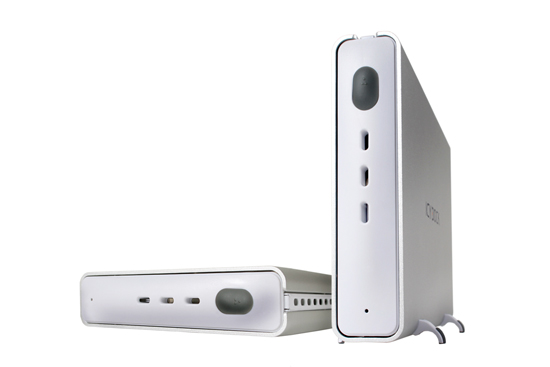
ICY DOCK MB664US-1S
| ICY DOCK MB664US-1S Specifications | |
| Host Interface | eSATA + USB 2.0 Combination |
| Drive Type | 3.5" SATA 1.5Gb/s or 3Gb/s Interface |
| Drive Position | Vertical or Horizontal |
| Transfer Rates | Up to 3Gb/s per eSATA specs Up to 480Mb/s per USB 2.0 specs |
| Connection Type | SATA |
| Structure Type | Aluminum Body with Plastic Trim |
| Drive Cooling | Passive via Aluminum frame heat dispersion with ventilation ports |
| Activity Indicators | Device Power and Drive Activity via LED |
| OS Support | Windows 98/SE/ME/2000/XP/Vista, Mac OS 9.0 or higher |
| Power Draw | 2W |
| Dimensions (LxWxH) | 194 x 142.6 x 42.6 mm |
| Weight | 1.10 lbs. |
The ICY DOCK MB664US-1S is a relatively small, single-drive enclosure comprised of aluminum and plastic. Remaining true to ICY DOCK's unspoken product mantra of "attractive, but not flashy" hardware, the unassuming MB664US-1S has a brushed silver outer shell, with the modest ICY DOCK logo. The middle of the enclosure is ringed by a white strip, providing drive access, ventilation, and the external ports. The front panel is plastic, while all other outwardly facing surfaces are metal.
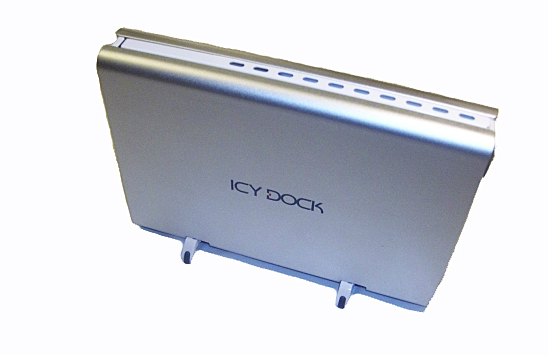
The ICY DOCK MB664 has no active cooling solution, instead relying on the aluminum exterior shell and a small series of ventilation holes along one side of the enclosure to dissipate the heat emitted by modern hard drives.
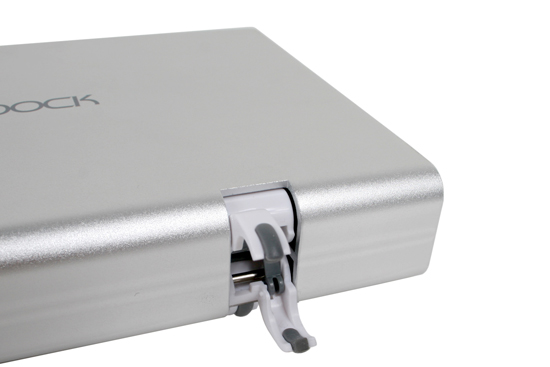
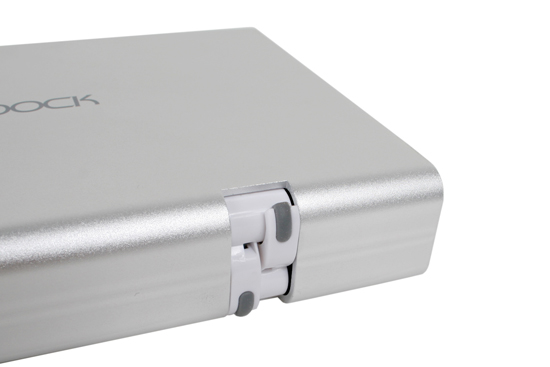
Rather than providing a snap-in stand for the MB664US, ICY DOCK has come up with a clever open/close scissor configuration. With the mount in the closed position, the unit can rest on its side, with the edge of the pad protruding only a couple of millimeters from the main shell. With the mounts opened, the unit stands on its side, seated on small rubber feet. Drive cooling proved to be slightly better with the unit resting on its side in the "open scissor" configuration, though no issues were encountered in either configuration.
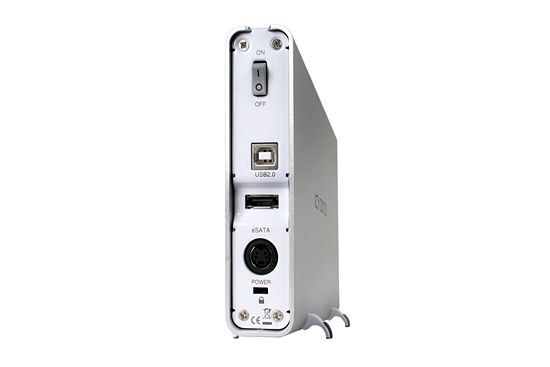
As previously mentioned, the MB664US-1S is configured to support both USB2.0 and eSATA drives. Interestingly, ICY DOCK has chosen to include a security cable slot on the MB664US line of enclosures, providing a basic level of security for users. A power switch and connector are the only other items on the MB664's back panel.
The most interesting feature of the MB664US-1S is its "tool-less" design. The front of the enclosure has a lock/unlock switch and a push button which provides access to the slide-in caddy for hard drive installation.
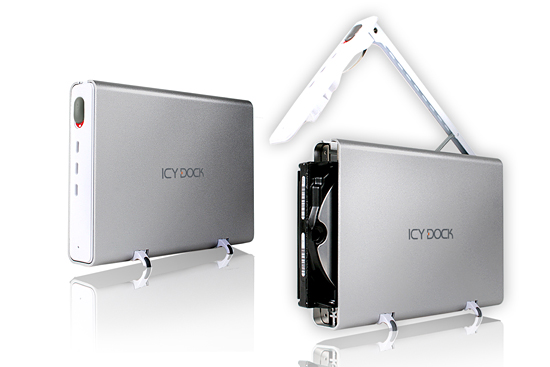
No tools are required to mount (or dismount) the hard drive, and there is no detachable drive caddy to worry about at all. This proved to be a mixed blessing, however, as drive installation and removal did take a little bit of practice before things went smoothly. While it is unclear that a user would ever have a need to open the front of the enclosure during drive operation, this was nevertheless an impossible task, as the drive eject arm is part of the same mechanism as the front panel cover.
The backplane itself is minimal (as in the MB559US), and is held in by four screws. ICY DOCK does provide a single LED in the front of the enclosure to indicate drive operation status, though the LED has only a pinhole cutout in the front panel, limiting the effectiveness of the LED somewhat.
The word "PUSH" shown in the drive pictures is actually a sticker, and can be removed with ease (and without leaving residue on the front panel). It was left on to show the means to open the enclosure, as there is otherwise no indication on the unit.
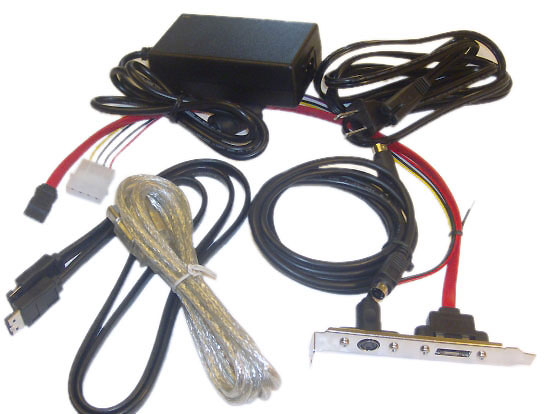
True to form for ICY DOCK, the included accessory kit has everything required to operate the drive either in USB or eSATA mode, including both external cables. For users who want additional flexibility, ICY DOCK offers a "Hybrid" bracket housing both an external SATA connector (converting from an internal SATA port) as well as a connector going from an internal 4-pin Molex plug to the external power adapter required by the enclosure. This gives the user the ability to either power the enclosure using their internal PC power supply, or using the standard power brick included in the packaging. Please note that this bracket is sold separately, and is not included in the base package (as was originally written in this space - our apologies for the error).
As we noted in our earlier review of the ICY DOCK MB559US, proper chipset support of eSATA is strongly recommended in order to use this enclosure with the internal-external SATA connector adapter. Modern SATA chipsets should be fine, but exercise caution particularly with early VIA chipsets or the Intel ICH6.
Test Setup
| Standard Test Bed Playback of iPEAK Trace Files and Test Application Results |
|
| Processor | Intel QX6700 - 2.66GHz Quad Core |
| Motherboard | DFI Infinity 965-S |
| RAM | 2 x 1GB OCZ Reaper PC2-9200 Settings - DDR2-800 - 3-4-3-9 |
| OS Hard Drive | 1 x Western Digital WD1500 Raptor - 150GB |
| System Platform Drivers | Intel 8.1.1.1010 Intel Matrix RAID 6.2.1.1002 |
| Video Card | 1 x MSI 8800GTX |
| Video Drivers | NVIDIA ForceWare 158.19 |
| Optical Drive | Plextor PX-760A, Plextor PX-B900A |
| Cooling | Tuniq 120 |
| Power Supply | Corsair HX620 |
| Case | Cooler Master CM Stacker 830 |
| Operating System | Windows XP Professional SP2 |
We are utilizing an Intel QX6700 quad core CPU to ensure we are not CPU limited in our testing. A 2GB memory configuration is standard in our XP test bed as most enthusiasts are currently purchasing this amount of RAM. Our choice of high-range OCZ Reaper PC2-9200 memory offers a very wide range of memory settings with timings of 3-4-3-9 used for our benchmark results.
Our test bed now includes a water-cooled MSI 8800 GTX video card to ensure our game tests are not completely GPU bound and to reduce noise/heat levels. Our video tests are run at 1280x1024 for this article at High Quality settings. All of our tests are run in an enclosed case with a dual optical/hard drive setup to reflect a moderately loaded system platform. Windows XP SP2 is fully updated and we load a clean drive image for each system to keep driver conflicts to a minimum.
The drive is formatted before each test run and five tests are completed on each drive in order to ensure consistency in the benchmark results. The two high and low scores are removed with the remaining score representing our reported result. We utilize the Intel ICH8R SATA ports along with the latest Intel Matrix Storage driver to ensure consistency in our playback results when utilizing NCQ, TCQ, or RAID settings.
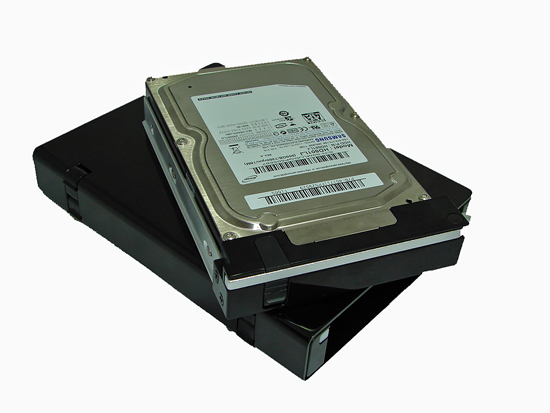
Our test drive today will be the Samsung SpinPoint T166 500GB that we recently reviewed. We implemented AHCI (Advanced Host Controller Interface) in the BIOS to properly test the hot swap capabilities of this drive enclosure when utilizing the eSATA interface. Without the proper matrix storage driver support and AHCI implementation, hot swapping was not possible with our test bed.
Acoustics
Our acoustic test utilizes our standard test bed components but we implement Intel's power saving technology and turn off the case fans to isolate as much case noise as possible during testing. Our Corsair power supply is nearly silent in these tests and our MSI 8800GTX video card is water cooled to provide a further decrease in ambient noise levels.
Our acoustic tests are designed to measure the decibel levels while the system is at idle and also under load while running the General Hard Disk Drive Usage benchmark within PCMark 2005. We found through trial and error that this particular benchmark produces controlled readings across a wide range of applications within the benchmark. This particular benchmark utilizes 60% reads and 40% writes within the trace playback file.
The measurements are taken at a distance of 5mm from the rear and front of the drive being tested in order to minimize surrounding environmental noise. We have noticed that unless we run a completely silent system in a quiet room that measurements taken from 1m are generally not meaningful due to ambient noise levels. Being an external enclosure that might be found sitting on a desk, HDD noise levels with the ICY DOCK may be slightly more noticeable than a hard drive installed in a typical tower.
The reported measurements are based on an A-weighted decibel score that measures frequencies similar to the way the human ear responds to sound. We take a total of three measurements for each test. We then subtract the high and low scores and arrive at our findings by reporting the remaining score.
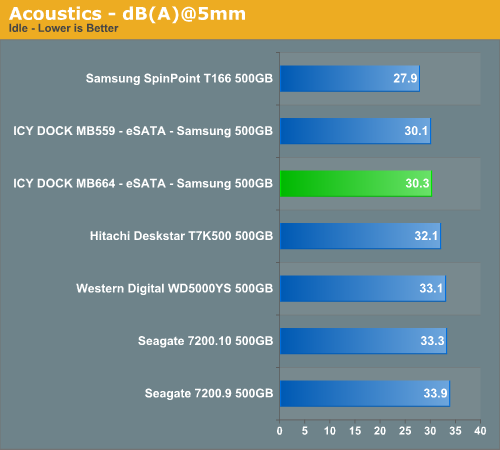
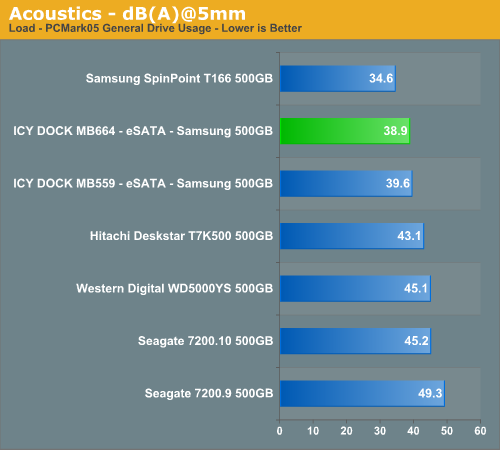
The MB664 comes in slightly quieter than the MB559, largely due the MB664's use of a "slide-in" design, rather than a detachable caddy. The difference, however, is minor and not likely to be noticeable in most conditions. As in the review of the MB559, the SpinPoint drive in the review has a tendency to vibrate, which caused a hum in our ICY DOCK enclosure. Our base noise level in the room at the time of testing was 25 dB(A).
Thermals
Our thermal tests utilize sensor readings via the S.M.A.R.T. (Self-Monitoring, Analysis and Reporting Technology) capability of the drives and are reported by utilizing the Active SMART 2.42 utility. We also utilize thermal sensors and infrared measurement devices to verify our utility results. Our base temperature level in the room at the time of testing was 25C.
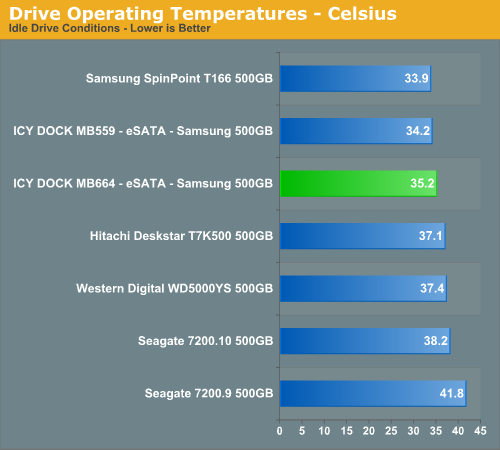
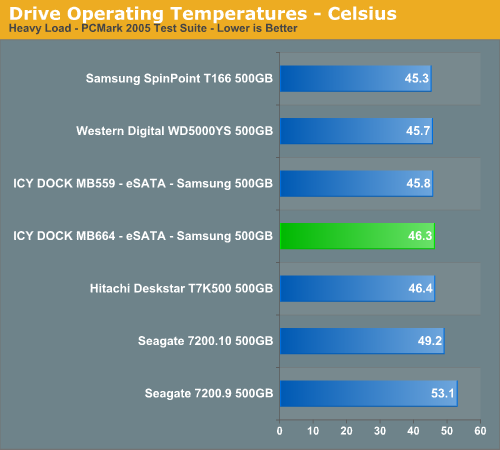
The ICY DOCK MB664 was able to dissipate the heat of the Samsung drive without issue. As was the case in the MB559, the enclosure itself consumes only 2W of power at idle, largely due to the absence of any active cooling solution. This low power consumption contributes to the low thermal output increases we noticed compared to the drive in a standard case configuration.
PCMark05 Performance
We are utilizing the HDD test suite within PCMark05 for further comparative hard disk scores as it provides a mixture of actual application results and specific read/write percentages utilized within these programs. It is also a readily available benchmark that others can use for comparative purposes. The program utilizes the RankDisk application within the Intel iPEAK SPT suite of tools to record a trace of disk activity during usage of real world applications. These traces are then replayed to generate performance measurements based upon the actual disk operations within each application. The HDD test suite contains 53% read and 47% write operations with each trace section utilizing varied amounts of read or write operations. Additional information about the test suite can be found in PDF format here PCMark05 whitepaper.
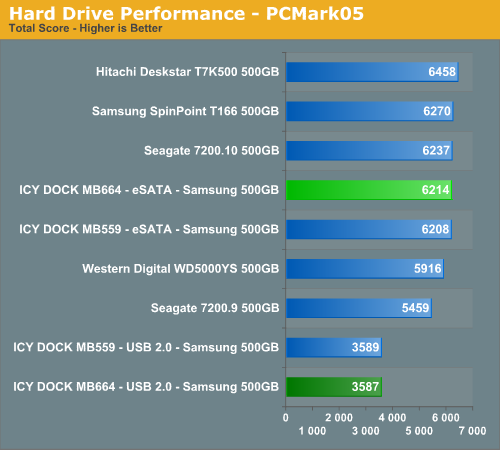
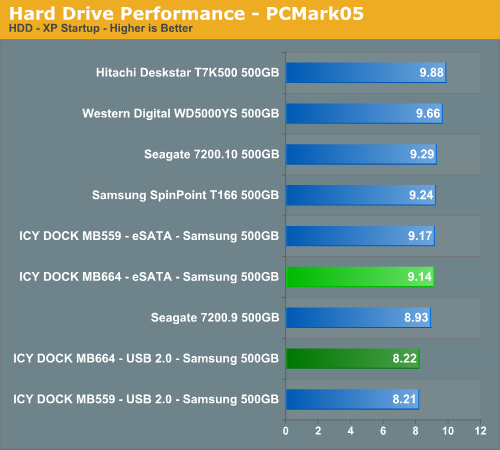
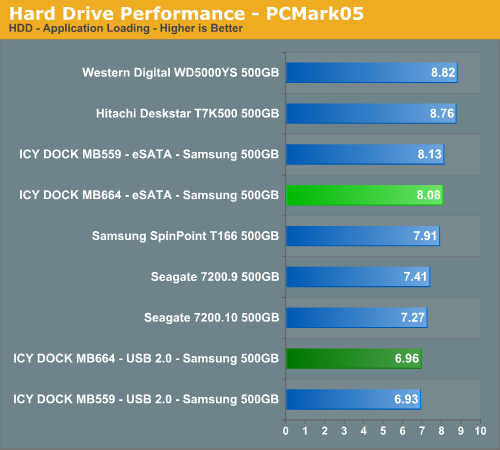
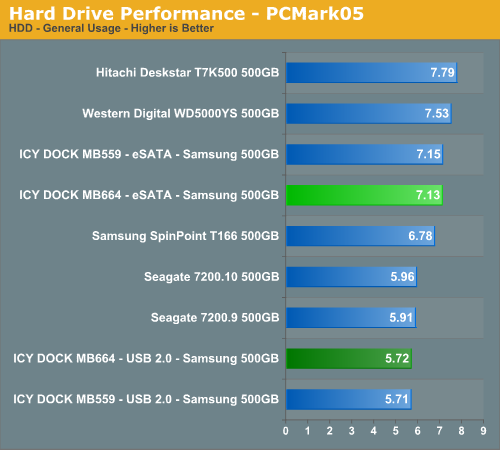
Continuing previous trends, the scores of the MB664 are virtually identical to the MB559. The eSATA scores easily trounce the scores under USB, as is expected.
Application Tests
Our application benchmarks are designed to show application performance results with times being reported in seconds, with lower scores being better. While these tests will show some differences between the drives it is important to understand we are not measuring the pure performance of the hard drive but how well our platform performs with each individual drive. The performance of a hard drive is an integral part of the computer platform but other factors such as memory, CPU, core logic, and even driver choice can play a major role in determining how well the hard drive performs in any given task.
As the results of these tests can be largely predicted at this point in time, we'll reserve comment until the end.
AnyDVD 6.1
This test has us utilizing the "ripping" function of AnyDVD to copy the Office Space DVD file from our source drive to our test drive. Our DVD features 29 files totaling 7.55GB of data and is an excellent test for determining the write speed of a drive.
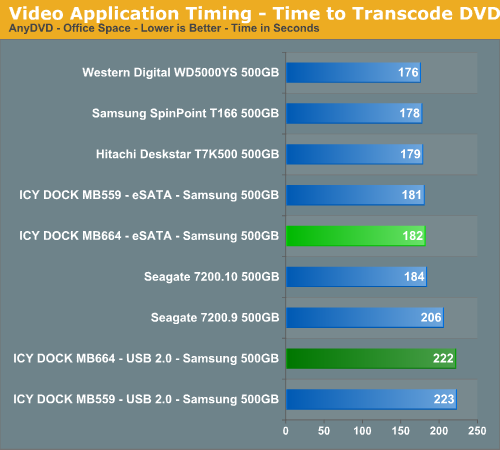
Game Load Test
Our Sims 2: Open for Business test measures the time it takes to load the initial portion of the game. Our application timer starts when the game icon is initiated until the neighborhood menu appears.
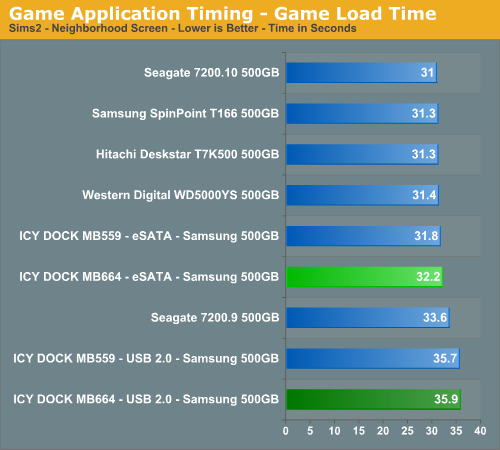
Game Level Load
This test centers on the actual loading of a playable level within our game selections. The Battlefield 2 test measures the time it takes to load the Daqing Oilfields level. Our application timer begins when the start single player icon is initiated and ends when the join game icon is visible.
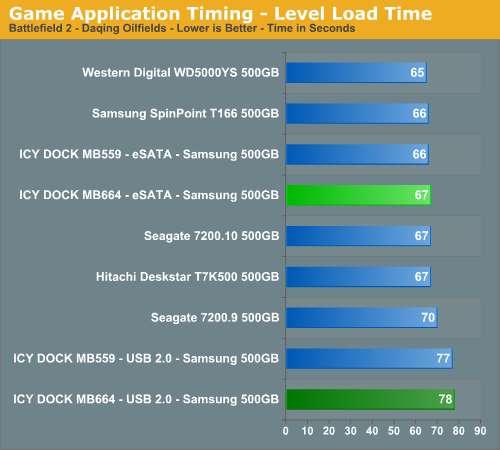
File Copy Performance
Our file copy test measures the time it takes to transfer our test folder that contains 29 files, 1 folder, and has 7.55GB of data from our source drive to the target test drive. This benchmark is disk write intensive and requires a fast storage system. The second test does copies the same folder on the test drive to another folder on the same drive.
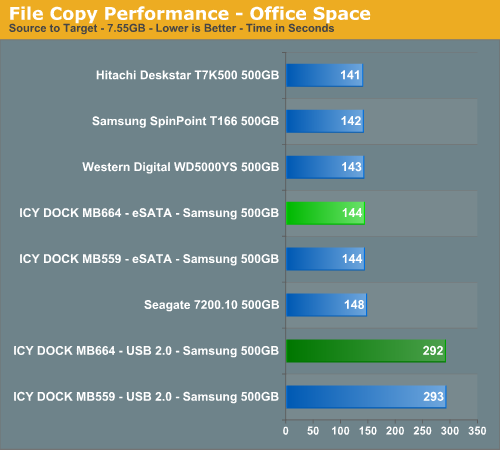
Conclusion
We previously reviewed the MB664's less-expensive sibling, the MB559, and our performance results here are virtually identical. Indeed, the MB664 seems to share the same PCB components (albeit arranged in a slightly different configuration) with the MB559, so this was largely an expected result.
Where the two products differ is in the packaging, the PC adapter which is included with the products, and in the treatment of the hard drive itself. The MB664's "tool-less" installation of the drive works flawlessly, and (unlike the 559) there is no need to remove a caddy to install the hard drive. In our tests, installation was relatively straightforward, though we did find ourselves checking from time to time to make sure that the drive's connector was seated properly in the PCB. (There was never an issue with this - the uncertainty was simply because the PCB is completely hidden by the drive the moment it is put into the enclosure).
The addition of a power socket on the back of the PC adapter is interesting, though we do wonder how often it will really be used. A big part of the attraction of an external enclosure like this, after all, is portability - if you only have the power cord for the PC adapter, then the enclosure is restricted to that unit (even with USB). Nevertheless, it's clear that there are uses for the MB664 that go beyond simple portability, and the ability to not occupy another wall socket is a welcome one.
The fit and finish of the MB664 is nearly flawless. Everything fits together perfectly and feels very secure, without any flimsy bits. ICY DOCK has designed their MB664 (like the MB559) extremely well. On the negative side, the MB664 could do with a more secure stand. The scissor-style feet hold the unit properly, though larger feet could have provided more stability. Equally, while the front panel on the MB664 is adequate for the job, a more satisfying "click" during closure (or, conversely, a more energetic response when the unit is opened) would be welcome.
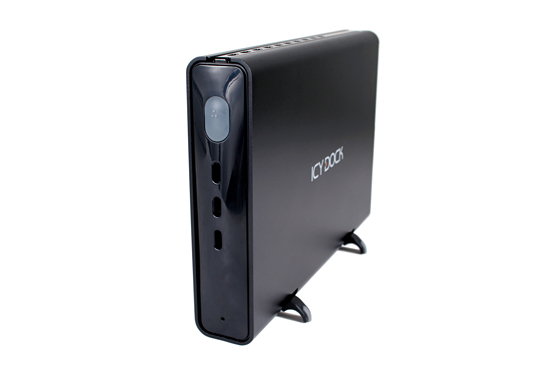
The street price for the MB664 hovers around $70 and is available both in the silver aluminum finish, or a glossy black (similar to the one in our MB559 article). For the $15 premium attached to the MB664 compared to the MB559, the user gets the aforementioned option to draw power from a PC power supply, as well as the simpler hard drive installation. For most users, we believe the MB664 is the way to go on the strength of its slightly-more-secure hard drive installation, though in truth both products are exceptional offerings at their respective price points.







